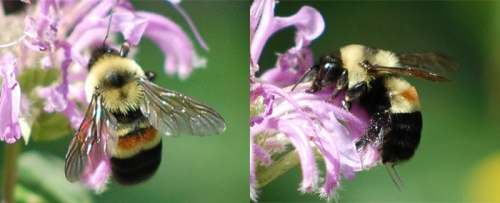Native Pollinators On Farms

Our Projects |
Pesticides |
Native bees |
Resources |
Education |
|---|
What are Neonicotinoids?
Neonicotinoids are a class of insecticides that have been in use since the 1990s. They include 5 active ingredients—clothianidin, imidacloprid, thiamethoxam, sulfoxaflor, thiacloprid, and acetamiprid. They are sold under myriad brand names either singly, stacked together, or stacked with fungicides.
Neonicotinoids are being used widely in agriculture and on golf courses to control sucking and biting pest insects, and as flea control in pets. In Ontario agriculture, neonicotinoids are registered for use on every crop grown with the exception of some forage crops: The list includes everything from fruits, vegetables, field crops such as corn, soyabeans, canola, and grains, herbs, Christmas trees, ginseng, trees, turfgrass, and nursery plants.
Often neonicotinoids are used as prophylactic measure, applied before there is any pest pressure, “just in case”. Close to 100% of all non-organic corn and 80% of non-organic soyabean grown in Ontario has neonicotinoids applied to it as a prophylactic seed coating. The Ontario Ministry of Agriculture and Food (OMAF) has summarized the real risks to field crops in Ontario of pests that are targeted by neonicotinoids demonstrating that much of that use is unnecessary.
Neonicotinoids pose a unique threat to native pollinators and beneficial insects because they are highly potent neurotoxins that are systemic in nature. Regardless of application method (as a seed coating, foliar spray, soil drench, or injection into trees), neonicotinoids are taken up by plants and spread throughout the whole plant system, including the nectar and/or pollen of flowering plants. Pollinators come in contact with neonicotinoids by consuming tainted nectar and/or pollen from both insect-pollinated plants and wind-pollinated plants such as corn, grains, and trees, and by coming in contact with the dust of tainted lubricants that are used at planting time to plant treated seeds.
Neonicotinoids cause a variety of symptoms in pollinators. These include death if the pollinator consumes a lethal dose. When pollinators are exposed to neonicotinoids at sub-lethal levels, the compounds have been proven to reduce longevity, brood production, hypopharyngeal gland development, egg laying, to impair cognitive function, and to reduce foraging and reproductive efficiency of native bees. Neonicotinoids are increasingly being linked to colony collapse disorder (CCD) in honey bees. A scientific review of the impacts of neonicotinoid insecticides on pollinators and other non-target living things such as birds and aquatic invertebrates can be found here and an excellent film on the topic can be found here.
Guidelines for neonicotinoid applications are produced based on the lethal dose for the honey bee and on its foraging habits. However native bees vary considerably in size from the honey bee and do not follow the same foraging or lifecycle patterns, and in some cases may be at higher risk of exposure to neonicotinoids both in the adult and larval stages for a variety of reasons.
For more complete information about neonicotinoids see Farms at Work’s Ten Facts About Neonicotinoid Use in Ontario.




